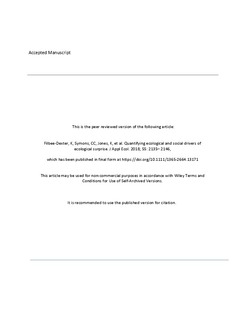| dc.description.abstract | 1.A key challenge facing ecologists and ecosystem managers is understanding what drives unexpected shifts in ecosystems and limits the effectiveness of human interventions. Research that integrates and analyses data from natural and social systems can provide important insight for unravelling the complexity of these dynamics. It is, therefore, a critical step towards the development of evidence‐based, whole‐system management approaches. 2.To examine our ability to influence ecosystems that are behaving in unexpected ways, we explore three prominent cases of “ecological surprise.” We captured the social‐ecological systems (SES) using key variables and interactions from Ostrom’s SES framework, which integrates broader ecosystem processes (e.g. climate, connectivity), management variables (e.g. quotas, restrictions, monitoring), resource use behaviours (e.g. harvesting) and the resource unit (e.g. trees, fish, clean water) being managed. 3.Structural equation modelling revealed that management interventions often influenced resource use behaviours (e.g. rules and limits strongly affected harvest or pollution), but they did not have a significant effect on the abundance of the managed resource. Instead, most resource variability was related to ecological processes and feedbacks operating at broader spatial or temporal scales than management interventions, which locked the resource system into the degraded state. 4.Synthesis and applications. Mismatch between the influence of management systems and ecosystem processes can limit the effectiveness of human interventions during periods of ecological surprise. Management strategies should shift from a conventional focus on removal or addition of a single resource towards solutions that influence the broader ecosystem. Operationalizing Ostrom’s framework to quantitatively analyse social‐ecological systems using structural equation models shows promise for testing solutions to navigate these events. | nb_NO |
